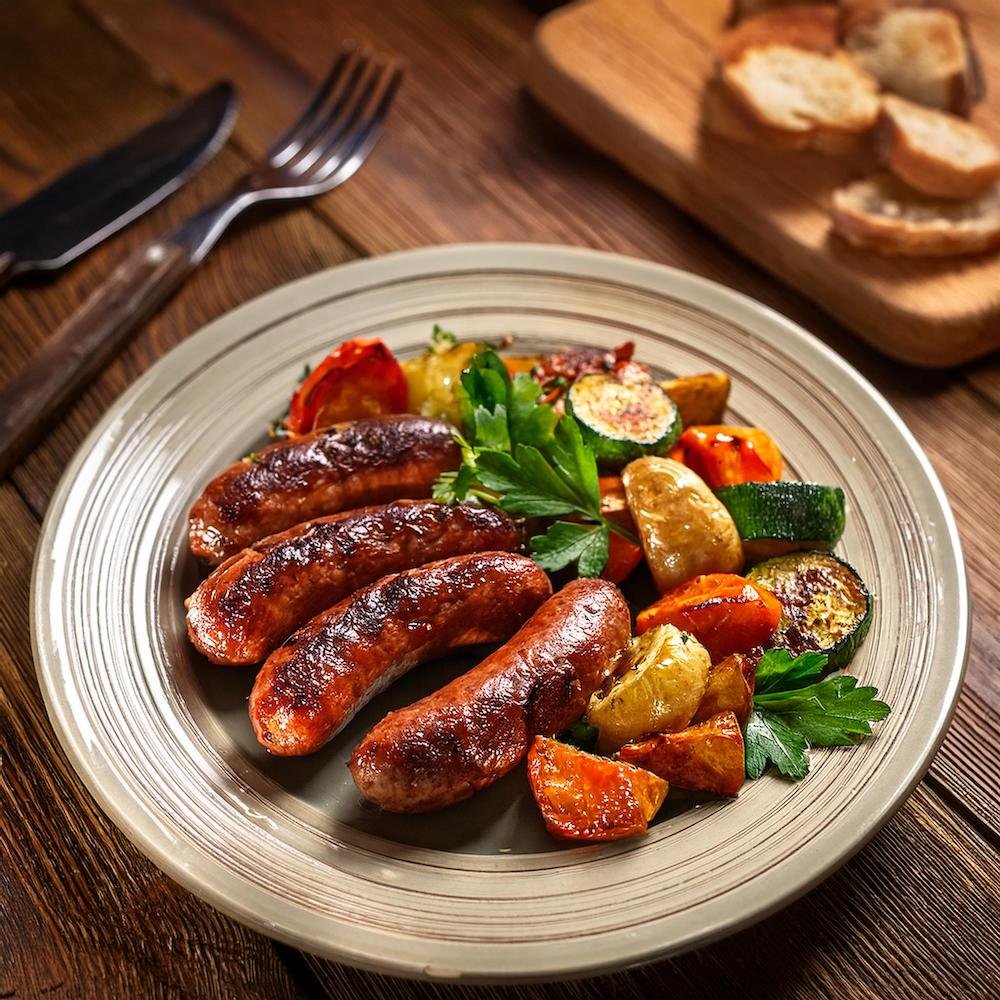Is beef chorizo healthy? is a popular ingredient in many cuisines, celebrated for its bold, smoky, and spicy flavor. Whether used in tacos, casseroles, or breakfast dishes, it adds a unique taste that enhances meals. But when it comes to health, how does beef chorizo measure up?
While beef chorizo is packed with protein and flavor, it’s also high in fat and sodium, which can impact its role in a healthy diet. The key lies in understanding its nutritional profile, benefits, and potential downsides—and making informed choices to enjoy it in moderation.
In this article, we’ll explore whether beef chorizo is healthy, how to make it a better fit for your diet, and ways to enjoy it while staying mindful of its nutritional impact.
Nutritional Facts About Beef Chorizo
Is beef chorizo healthy? The answer depends on how it’s prepared and consumed. The nutritional content varies between homemade and store-bought options, but here’s a general breakdown:
Macronutrient Content
- Calories:
- A 2-ounce serving of beef chorizo typically contains 150–200 calories.
- Calories may increase with fattier cuts of beef or added ingredients.
- Protein:
- Beef chorizo provides 10–15 grams of protein per serving, supporting muscle repair and growth.
- Fats:
- It contains 12–18 grams of fat, with a mix of saturated and unsaturated fats.
- Saturated fats can contribute to high cholesterol if consumed in excess.
- Carbohydrates:
- Most beef chorizo is low in carbs, with 0–2 grams per serving, making it keto-friendly.
Micronutrient Content
- Sodium:
- Store-bought chorizo is high in sodium, ranging from 500–700 milligrams per serving.
- High sodium intake can impact heart health if not balanced with other foods.
- Vitamins and Minerals:
- Beef chorizo contains small amounts of iron, zinc, and B vitamins, which support energy production and immune health.
Pro Tip: Opt for homemade chorizo to control fat, sodium, and calorie content while still enjoying its rich flavor.
Health Benefits of Beef Chorizo
While beef chorizo should be consumed in moderation, it does offer some health benefits, particularly when incorporated thoughtfully into a balanced diet.
1. High Protein Content
- Muscle Health:
- With 10–15 grams of protein per serving, beef chorizo supports muscle repair, growth, and overall body function.
- Satiation:
- Protein-rich foods like beef chorizo can help you feel fuller for longer, reducing the temptation to overeat.
Pro Tip: Pair beef chorizo with vegetables or whole grains for a more balanced meal that maximizes its protein benefits.
2. Rich Flavor Enhances Dishes
- Small Portions, Big Flavor:
- The bold and smoky taste of beef chorizo allows you to use smaller portions while still adding significant flavor to dishes.
- A little goes a long way in tacos, casseroles, or breakfast hashes.
Pro Tip: Use beef chorizo as a seasoning or topping rather than the main ingredient to keep portions in check.
3. Source of Essential Nutrients
- Iron and Zinc:
- Beef chorizo provides small amounts of these minerals, which are essential for red blood cell production and immune function.
- B Vitamins:
- Contains vitamins like B12 and niacin, which help convert food into energy and support nerve health.
Pro Tip: Combine beef chorizo with other nutrient-dense foods, like leafy greens or legumes, to boost the overall nutritional value of your meal.
4. Versatility in Healthy Recipes
- Adaptable to Various Diets:
- When used in moderation, beef chorizo can fit into low-carb, keto, or high-protein diets.
- It pairs well with vegetables, eggs, and whole grains for creative, flavorful meals.
Pro Tip: Opt for leaner ground beef when making homemade chorizo to cut back on fat while retaining its bold flavor.
Potential Downsides of Beef Chorizo
While beef chorizo has its benefits, there are some nutritional drawbacks to consider, particularly if it’s consumed frequently or in large quantities. Understanding these potential downsides can help you make informed dietary choices.
1. High Fat Content
- Saturated Fats:
- A 2-ounce serving of beef chorizo contains 12–18 grams of fat, a significant portion of which is saturated fat.
- High intake of saturated fats can contribute to elevated cholesterol levels and increase the risk of heart disease.
- Calorie Density:
- The high fat content makes beef chorizo calorie-dense, which can hinder weight management if not portioned carefully.
Pro Tip: Choose leaner beef for homemade chorizo or drain excess fat during cooking to reduce overall fat content.
2. High Sodium Levels
- Sodium Content:
- Store-bought beef chorizo contains 500–700 milligrams of sodium per serving, which is 20–30% of the recommended daily intake.
- High sodium intake can lead to water retention and increase blood pressure over time.
Pro Tip: Opt for low-sodium versions or make your own chorizo to control the salt content.
3. Processed Nature of Store-Bought Options
- Additives and Preservatives:
- Many pre-packaged beef chorizo products include additives, preservatives, or fillers that may not align with a clean eating lifestyle.
- These ingredients can contribute to hidden calories and potential allergens.
Pro Tip: Read ingredient labels carefully when buying store-bought chorizo, and choose brands with minimal additives and natural seasonings.
4. Imbalance in Nutritional Profile
- Low Fiber Content:
- Beef chorizo is low in dietary fiber, making it important to pair with fiber-rich foods like vegetables or whole grains.
- Limited Micronutrient Density:
- While beef chorizo provides some vitamins and minerals, it lacks the broad nutrient profile of more whole-food-based protein sources.
Pro Tip: Serve beef chorizo alongside nutrient-dense ingredients to balance your meal and boost overall nutrition.
Tips for Making Beef Chorizo Healthier
With a few adjustments and smart choices, you can enjoy beef chorizo while minimizing its drawbacks. These tips will help you create a healthier version of this flavorful ingredient or incorporate it into your diet more responsibly.
1. Use Lean Ground Beef
- Why It Helps:
- Choosing ground beef with lower fat content (e.g., 90/10 or 93/7) reduces overall saturated fat and calorie intake.
- How to Do It:
- When making homemade chorizo, opt for lean beef or mix lean beef with ground turkey for a lighter alternative.
Pro Tip: Add a small amount of olive oil to retain moisture and enhance flavor if using very lean meat.
2. Control the Sodium
- Why It Helps:
- Lowering the sodium content can reduce the risk of high blood pressure and water retention.
- How to Do It:
- Make your own chorizo to control the amount of salt in the recipe.
- If buying pre-packaged chorizo, look for low-sodium or reduced-salt options.
Pro Tip: Enhance the flavor with herbs and spices like garlic, cumin, and smoked paprika instead of relying on salt.
3. Reduce Portion Sizes
- Why It Helps:
- Smaller portions can limit calorie and fat intake while still delivering bold flavor.
- How to Do It:
- Use beef chorizo as a garnish or seasoning rather than the main ingredient.
- Combine it with other proteins like beans or tofu to stretch the portion size without sacrificing taste.
Pro Tip: Use beef chorizo sparingly in tacos, salads, or casseroles to enjoy its flavor without overindulging.
4. Pair with Nutrient-Dense Foods
- Why It Helps:
- Pairing beef chorizo with fiber-rich and nutrient-dense foods can balance the meal and promote satiety.
- How to Do It:
- Serve beef chorizo with roasted vegetables, whole grains, or leafy greens.
- Add fresh avocado, salsa, or citrus for added vitamins and healthy fats.
Pro Tip: Use beef chorizo as a topping for sweet potatoes or a filling for bell peppers to create a balanced dish.
5. Choose Healthier Cooking Methods
- Why It Helps:
- Using lighter cooking techniques reduces added fats and calories.
- How to Do It:
- Avoid frying and instead sauté or grill beef chorizo.
- Drain excess fat from the skillet after cooking to further cut down on grease.
Pro Tip: Use non-stick pans or a light mist of cooking spray to minimize additional oils.
Balanced Ways to Include Beef Chorizo in Your Diet
Beef chorizo can be part of a balanced diet when consumed thoughtfully and paired with wholesome ingredients. These strategies will help you enjoy its bold flavors while keeping your meals nutritious.
1. Pair with Vegetables
- Why It Works:
- Vegetables add fiber, vitamins, and minerals to balance the richness of beef chorizo.
- Ideas for Pairing:
- Sauté chorizo with spinach, kale, or zucchini for a nutrient-packed dish.
- Add cooked chorizo to roasted vegetable medleys or use it as a topping for stuffed bell peppers.
Pro Tip: Mix beef chorizo with cauliflower rice or broccoli for a low-carb, high-flavor option.
2. Serve with Whole Grains
- Why It Works:
- Whole grains like quinoa, brown rice, or farro provide fiber and protein, helping balance the meal.
- Ideas for Pairing:
- Toss beef chorizo into a grain bowl with black beans, avocado, and salsa.
- Use chorizo as a protein-packed topping for quinoa-stuffed tomatoes or squash.
Pro Tip: Create a balanced burrito bowl by combining chorizo with rice, beans, and a variety of colorful vegetables.
3. Incorporate into Breakfast Dishes
- Why It Works:
- Pairing beef chorizo with eggs or whole-grain toast creates a satisfying, protein-rich breakfast.
- Ideas for Breakfast:
- Scramble chorizo with eggs and spinach, then serve with a side of fruit.
- Top avocado toast with crumbled chorizo and a poached egg for a flavorful twist.
Pro Tip: Use beef chorizo in moderation to add flavor without overpowering the dish.
4. Make It a Flavor Enhancer
- Why It Works:
- A small amount of beef chorizo can elevate the taste of soups, stews, and casseroles.
- Ideas for Enhancing Dishes:
- Stir cooked chorizo into lentil soup or chili for added depth and smokiness.
- Sprinkle crumbled chorizo over a baked sweet potato or salad for a bold topping.
Pro Tip: Combine chorizo with lighter proteins, such as chicken or turkey, to stretch its flavor further.
5. Focus on Portion Control
- Why It Works:
- Limiting portion sizes reduces calorie and fat intake while allowing you to enjoy the taste.
- Ideas for Portioning:
- Use 1–2 ounces of beef chorizo per serving and complement it with other lean proteins or plant-based options.
- Add just enough chorizo to dishes like pasta or risotto to infuse flavor without overwhelming the meal.
Pro Tip: Pre-portion cooked chorizo into small containers for easy meal prep and portion control.
FAQs:
Is Chorizo Meat Good for You?
Yes, in Moderation: Chorizo is a flavorful source of protein and essential nutrients like iron and B vitamins. However, it’s high in fat, sodium, and calories, so it’s best enjoyed occasionally and in small portions.
Healthier Options: Choose leaner versions, like beef chorizo made with 90/10 ground beef, or make your own to control fat and sodium levels.
Pro Tip: Balance chorizo with fiber-rich vegetables and whole grains to create a nutritious meal.
Is Beef Chorizo Any Good?
Flavor and Versatility: Beef chorizo is widely loved for its bold, smoky, and spicy flavor, making it a versatile ingredient in many recipes. It’s a great alternative to pork chorizo for those who prefer beef or follow dietary restrictions.
Pro Tip: Use beef chorizo as a seasoning or protein boost in tacos, casseroles, or breakfast dishes to enhance their flavor.
Is Chorizo a Highly Processed Food?
Depends on the Type: Store-bought chorizo, especially pre-packaged varieties, is often processed with preservatives, additives, and higher levels of sodium.
Homemade chorizo or minimally processed brands are less processed and allow for more natural ingredients.
Pro Tip: Check ingredient labels on store-bought chorizo and look for options with fewer additives or make your own for a healthier choice.
Is Beef Chorizo Better Than Pork?
Nutritional Comparison: Beef chorizo tends to be leaner than pork chorizo, offering a slightly lower fat content while still delivering robust flavor.
Pork chorizo has a richer, juicier taste due to its higher fat content but is less suitable for those on a lower-fat diet.
Dietary Considerations: Beef chorizo is an excellent choice for those avoiding pork due to dietary restrictions or personal preference.
Pro Tip: Choose beef chorizo if you prefer a meatier flavor with less fat, and opt for pork chorizo when you want a more indulgent, savory taste.
Suggested Internal Links:
- What Is Beef Chorizo?
Learn more about the origins, preparation, and culinary uses of beef chorizo. - How Do You Wrap a Burger Patty in Lettuce?
Discover a low-carb way to enjoy beef chorizo by pairing it with a lettuce-wrapped burger. - What Does Date Palm Do to the Body?
Explore the health benefits of pairing beef chorizo with nutrient-dense date palm products. - Garlic Parmesan Chicken Pasta
Consider adding beef chorizo for a smoky twist to this creamy pasta dish. - What Can Be Made from Date Palm?
Discover how date palm-based products can complement dishes featuring beef chorizo.
Conclusion
Is beef chorizo healthy? The answer lies in how you prepare and consume it. While beef chorizo is a flavorful and protein-rich ingredient, its high fat and sodium content mean it should be enjoyed in moderation. By making smart choices—such as opting for leaner beef, controlling portion sizes, and pairing it with nutrient-dense foods—you can incorporate beef chorizo into a balanced diet.
Compared to pork chorizo, beef chorizo offers a leaner alternative with the same bold and smoky flavors. If you’re wondering, is beef chorizo healthy?, the key is to make thoughtful adjustments, like preparing it at home to control the ingredients or using it as a seasoning rather than the main protein source.
Whether used in tacos, breakfast bowls, or casseroles, beef chorizo adds a unique and irresistible taste to your meals. So, is beef chorizo healthy? It can be when balanced with wholesome ingredients and enjoyed responsibly. Give it a try and savor its rich flavors while keeping your health goals in mind!
Discover more mouthwatering recipes on our Web Site ! Stay connected and get inspired by following us on Facebook, Instagram, Pinterest, and Twitter for the latest updates!




